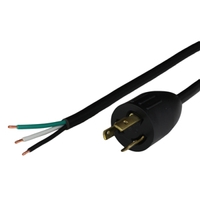Power Cordage : How to choose the right Gauge, Jacket, and Conductor Count
Created on: Feb 8, 2019
General Terms
Before we dive into the nitty-gritty of power cordages, let's define a few terms.
What is a Flexible Cord Jacket?
The jacket on a power cable is the outermost layer of the cable that surrounds the conductors. The jacket is typically the only part power of the cable you actually see, inside of the jacket are different current carrying conductors. The jacket of the cable protects the conductors inside from external forces and chemicals. The jacket does not affect the actual performance of the conductors inside, and is simply a way to protect the cable.
What is a conductor?
A conductor is the material inside that is used to carry current from one location to another. Common conductor materials include Copper, Aluminum, Gold, and Silver. Most power cables contain multiple conductors which serve different purposes. Conductors are wrapped inside of insulation, which keeps each conductor isolated from the others inside of the jacket.
What is insulation?
Insulation covers each conductor and is used to isolate each conductor.
What is shielding?
Shielding is a layer between the outer jacket of the cable, and the conductors on the inside. The shielding is typically composed of braided copper strands or a layer of another conducting polymer. We will discuss the shielding of cables later in this article.
Flexible Cord Jacket Designation Reference Chart
| Type | Description | AWG Size Range | Number of Conductors | Insulation / Jacket Material | Voltage | Applications | Temperature Rating (C) |
| TPT | Tinsel Parallel Thermoplastic | 27 Tinsel | 2 | PVC / No Jacket | 250 | 60 | |
| TS | Tinsel Service | 27 Tinsel | 2 | Rubber / Rubber | 125 | 60 | |
| TST | Tinsel Service Thermoplastic | 27 Tinsel | 2 | PVC / PVC | 125 | 60 | |
| SPT-1 | Service Parallel Thermoplastic – 1/64″ Insulation | 18 | 2 or 3 | PVC / No Jacket | 300 | Indoor use only: cords for lamps small fans, radios, televisions, etc. | 60,75,90,105 |
| SPT-2 | Service Parallel Thermoplastic – 2/64″ Insulation | 18-16 | 2 or 3 | PVC / No Jacket | 300 | Indoor use only: cords for lamps small fans, radios, televisions, etc. | 60,75,90,105 |
| SPT-3 | Service Parallel Thermoplastic – 3/64″ Insulation | 18-10 | 2 or 3 | PVC / No Jacket | 300 | Indoor use only: cords for lamps small fans, radios, televisions, etc. | 60,75,90,105 |
| SPE-1 | Service Parallel Elastomer – 1/64″ Insulation | 18 | 2 or 3 | Elastomer /No Jacket | 300 | ||
| SPE-2 | Service Parallel Elastomer – 2/64″ Insulation | 18-16 | 2 or 3 | Elastomer /No Jacket | 300 | ||
| SPE-3 | Service Parallel Elastomer – 3/64″ Insulation | 18-10 | 2 or 3 | Elastomer /No Jacket | 300 | ||
| SV | Service Vacuum | 18 | 2 or 3 | Rubber / Rubber | 300 | 60,75,90 | |
| SVO | SV with Oil Resistant Jacket | 18 | 2 or 3 | Rubber / Rubber | 300 | 60,75,90 | |
| SVOO | SVO with Oil Resistant Insulation | 18 | 2 or 3 | Rubber / Rubber | 300 | 60,75,90 | |
| SVT | Service Vacuum Thermoplastic | 18 or 17 | 2 or 3 | PVC / PVC | 300 | Indoor use only: Cords for vacuum cleaners, fans and portable lights. Extra flexible. | 60,75,90,105 |
| SVTO | SVT with Oil Resistant Jacket | 18 or 17 | 2 or 3 | PVC / PVC | 300 | Indoor use only: Cords for vacuum cleaners, fans and portable lights. Extra flexible. | 60,75,90,105 |
| SVTOO | SVTO with Oil Resistant Insulation | 18 or 17 | 2 or 3 | PVC / PVC | 300 | Indoor use only: Cords for vacuum cleaners, fans and portable lights. Extra flexible. | 60,75,90,105 |
| SVE | Service Vacuum Elastomer | 18 or 17 | 2 or 3 | Elastomer/Elastomer | 300 | 105 | |
| SVEO | SVE with Oil Resistant Jacket | 18 or 17 | 2 or 3 | Elastomer/Elastomer | 300 | 105 | |
| SVEOO | SVEO with Oil Resistant Insulation | 18 or 17 | 2 or 3 | Elastomer/Elastomer | 300 | 105 | |
| SJ | Service Junior | 18-10 | 2, 3 or 4 | Rubber / Rubber | 300 | 60,75,90 | |
| SJO | SJ with Oil Resistant Jacket | 18-10 | 2, 3 or 4 | Rubber /Neoprene | 300 | 60,75,90 | |
| SJOO | SJO with Oil Resistant Insulation | 18-10 | 2, 3 or 4 | PVC / PVC | 300 | 60,75,90 | |
| SJT | Service Junior Thermoplastic | 18-10 | 2, 3 or 4 | PVC / PVC | 300 | Hard usage indoors. | 60,75,90,105 |
| SJTO | SJT with Oil Resistant Jacket | 18-10 | 2, 3 or 4 | PVC / PVC | 300 | Hard usage indoors. | 60,75,90,105 |
| SJTOO | SJTO with Oil Resistant Insulation | 18-10 | 2, 3 or 4 | PVC / PVC | 300 | Hard usage indoors. | 60,75,90,105 |
| SJTW | SJT with Outdoor Jacket | 18-14 | 2, 3 or 4 | PVC / PVC | 300 | Hard usage outdoors: cords for lawn equipment, etc.. | 60,75,90,105 |
| SJE | Service Junior Elastomer | 18-10 | 2, 3, 4 or 5 | Elastomer/Elastomer | 300 | 105 | |
| SJWO | SJE with Oil Resistant Jacket | 18-10 | 2, 3, 4 or 5 | Elastomer/Elastomer | 300 | 105 | |
| SJEOW | SJEO with Outdoor Jacket | 18-10 | 2, 3, 4 or 5 | Elastomer/Elastomer | 300 | Hard usage outdoors: cords for lawn equipment, etc.. | 105 |
| SJEOO | SJEO with Oil Resistant Insulation | 18-10 | 2, 3, 4 or 5 | Elastomer/Elastomer | 300 | Hard usage outdoors: cords for lawn equipment, etc.. | 105 |
| S | Service | 18-2 | 2 or more | Rubber / Rubber | 600 | 60,75,90 | |
| SO | Service with Oil Resistant Jacket | 18-2 | 2 or more | Rubber /Neoprene | 600 | 60,75,90 | |
| SOO | SO with Oil Resistant Insulation | 18-2 | 2 or more | Rubber /Neoprene | 600 | 60,75,90 | |
| ST | Service Thermoplastic | 18-2 | 2 or more | PVC / PVC | 600 | Extra hard usage indoors: Heavy Industrial equipment. | 60,75,90,105 |
| STW | ST with Outdoor Jacket | 18-2 | 2 or more | PVC / PVC | 600 | Extra hard usage outdoors: Heavy Industrial equipment. | 60,75,90,105 |
| STO | ST with Oil Resistant Jacket | 18-2 | 2 or more | PVC / PVC | 600 | Extra hard usage outdoors: Heavy Industrial equipment. | 60,75,90,105 |
| SE | Service Elastomer | 18-2 | 2 or more | Elastomer/Elastomer | 600 | Extra hard usage outdoors: Heavy Industrial equipment. | 105 |
| SEO | SE with Oil Resistant Jacket | 18-2 | 2 or more | Elastomer/Elastomer | 600 | Extra hard usage outdoors: Heavy Industrial equipment. | 105 |
| SEOW | SEO with Outdoor Jacket | 18-2 | 2 or more | Elastomer/Elastomer | 600 | Extra hard usage outdoors: Heavy Industrial equipment. | 105 |
| SEOO | SEO with Oil Resistant Insulation | 18-2 | 2 or more | Elastomer/Elastomer | 600 | Extra hard usage outdoors: Heavy Industrial equipment. | 105 |
| HPN | Heater Parallel Neoprene | 118-12 | 2 or 3 | Neoprene /No Jacket | 300 | 105 | |
| HSJ | Heater Service Junior | 18-12 | 2, 3 or 4 | Neoprene / Rubber | 300 | ||
| HSJO | HSJ with Oil Resistant Jacket | 18-12 | 2, 3 or 4 | Neoprene /Neoprene | 300 | ||
| HS | Heater Service | 14-12 | 2, 3 or 4 | Neoprene / Rubber | 300 | ||
| HSO | Heater Service with Oil Resistant Jacket | 14-12 | 2, 3 or 4 | Neoprene /Neoprene | 300 | ||
| SRDT | 10-6 | 3 or more | Vinyl Plastic | N/A | Range and Dryer Cords |
Temperature Ratings on Power Cable Jackets
One of the most overlooked specification on power cable jackets is the temperature rating. It is critical that you ensure the power cables you are purchasing are able to withstand the heat of the environment they are located in. For environments that might exceed 60C (~ 140F), it is critical to ensure the cable you are using has a higher rating.
World Cord Sets stocks most of it's cables using 105C cable to ensure that our cables can withstand harsh environments.
General Information about Wire Gauge
Choosing wire gauge is very important to ensuring the correct function of your device. Wire gauge refers to the thickness of the conductor that will be carrying the current. The AWG of the wire will affect how much current (measured in Amps) can flow through the conductor. The below below shows the UL (Underwriters Laboratories) standard ampacity ratings for each gauge wire.
AWG (American Wire Gauge)
The AWG is the standard unit for specifying the size of the conductor. The AWG is not intuitive to beginners because the smaller the AWG, the thicker the conductor.
Standard Power Cable Wire Gauge Chart
| AWG | Diameter (inches) | Diameter (mm) | Ampacity |
| 0 | 0.3249 | 8.251 | 125 |
| 1 | 0.2893 | 7.348 | 110 |
| 2 | 0.2576 | 6.544 | 95 |
| 3 | 0.2294 | 5.827 | 85 |
| 4 | 0.2043 | 5.189 | 70 |
| 5 | 0.1819 | 4.621 | |
| 6 | 0.1620 | 4.115 | 55 |
| 7 | 0.1443 | 3.665 | |
| 8 | 0.1285 | 3.264 | 40 |
| 9 | 0.1144 | 2.906 | |
| 10 | 0.1019 | 2.588 | 30 |
| 11 | 0.0907 | 2.305 | |
| 12 | 0.0808 | 2.053 | 20 |
| 13 | 0.0720 | 1.828 | |
| 14 | 0.0641 | 1.628 | 15 |
| 15 | 0.0571 | 1.450 | |
| 16 | 0.0508 | 1.291 | 13 |
| 17 | 0.0453 | 1.150 | |
| 18 | 0.0403 | 1.024 | 10 |
Understanding the Wire Gauges Available for Cord Sets
Now that we have reviews what wire gauge is, let's take a look at finding which wire gauges are available for use on specific cord sets. Below, we will look at a classic example of a C14 to C13 Jumper Cord Set.
Choosing the Gauge for Center C14 to C13 Power Cords
To begin choosing, we will need to know the maximum UL Ampere and Voltage rating for the male and female ends of the cord set.
- IEC 60320 C14 : 15A, 250V
- IEC 60320 C13 : 15A, 250V
Next we will need to know the smallest gauge wire that is UL approved to be used with each of these.
- IEC 60320 C14 : 17/18awg (translating to 10A)
- IEC 60320 C13 : 17/18awg (translating to 10A)
Now that we have this information, we can find all of the possible North American wire gauges that we can use with this cord set. By looking at the table above, we can see that between 18awg and 15A, there are three ampere ratings available.
- 14awg (15A)
- 16awg (13A)
- 18awg (10A)
Once we have found the possible wire gauges / ampere ratings, we can move onto choosing which one is correct for us.
Choosing the correct Wire Gauge
Once you have find the possible ampere ratings / wire gauges available for the cord set you are looking for, it it time to choose the wire gauge. In order to properly choose a wire gauge, you will need to know how much power your device will require.
How to calculate the current draw on IT equipment
Continuing the example above, we will now find out how many amps the server we are plugging our C14 to C13 cord set into requires.
The first step is to determine what the voltage output on your supply end will be. For this cord set, the voltage supply will either be 125V, or 250V. It is very important that you consult person in charge of power management at your facility to get this information.
The second step is to determine the wattage requirements of your device. This can typically be found on power supply unit on the server, or, in the technical documentation for the server.
Once we have this information, we can do our math. Using the formula Amps = Watts / Volts we can find our many amps our device will require.
For this example, we will say that our device will be operating at 250V and will require 750W. Using the equation above, the makes:
Amps = Watts / Volts
Amps = 750 / 250
Amps = 3A
So we can see that this cable only requires 3A, so we are safe to use the smaller, cheaper 18awg gauge cord set. However, if the device required more power, and was run of 120V, we may need a higher ampacity cable.
Amps = Watts / Volts
Amps = 1500 / 125
Amps = 12A
In the scenario above, the device will require 12A. Because this is very close to 13A, it is a good idea to bump up to the next available ampere rating. This means we would want a cord utilizing 14awg conductors to make it rated for 15A.
Choosing a Jacket
What factors influence which jacket to use?
There are many factors that influence which jacket is required for different situations. The primary factors are the environment in which the cable will be in, and the number of conductors inside of the jacket.
Different flexible cord jackets are capable of withstanding differing amounts of external forces and chemicals. Some are only for indoor use in dry environments, while others are meant for rugged outdoor use.
Some jackets may only be used for a few conductors, while others can contain upwards of 20 conductors in a single jacket.

Author:
Brian Sackett
Marketing & Development
Related Products

IEC 60320 Power Cords | Standard Data Center Power Cables
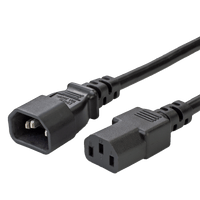
IEC 60320 C14 C13 Power Cords | Data Center Cords
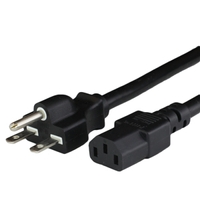
NEMA Power Cords
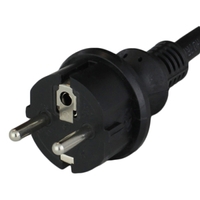
International Power Cords
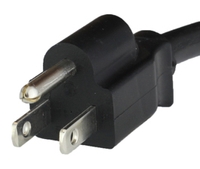
15A 125V NEMA 5-15P Power Cords
